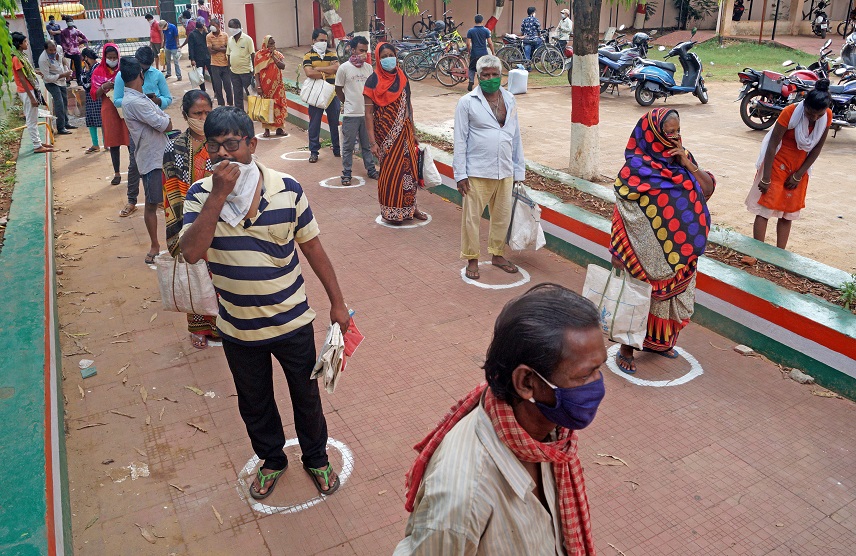The white ration card is issued to the families living below the poverty line, BPL. The yellow card is given to those families whose total annual income is more than the poverty line limit, APL. They get the benefit of food grains. The card colours can be different in different states.
Developmental aid is actually a strange story.
When it is the North world vs the South world, it smacks of the White Man’s burden. Then, if Graham Hancock’s book “Lords of Poverty” is anything to go by, much of that money goes back to the First World.
India has its much acclaimed MGNREGA (Mahatma Gandhi National Rural Employment Guarantee Act) programme. A beacon of hope for the poor in Covid times. While stories of MNREGA funds misuse creep up, they remain mostly buried in the inner pages of newspapers. Of course, the famous quote of an ex Prime Minister can never be forgotten. Only 15 paise of a rupee reaches the poor—less than one-fourth, that is. The remaining 85 paise is the riddle. Not really, though…
At the core of MNREGA and other “aid” programmes for the poor is the ubiquitous ration card. Rural India is fully tuned into the yellow and white of it.
The white ration card is issued to the families living below the poverty line—BPL. The yellow card is given to those families whose total annual income is more than the poverty line limit—APL. They get the benefit of food grains. (The card colours can be different in different states.)
So, here come some aid stories—from a five-ten-rupee town…offering clues to the 85 paise riddle.
Hemvati (name changed), a lady from one of the villages, came to my husband, pleading him to take a photograph of her with “a” buffalo. He happily complied and I accompanied him. After her picture, another lady came and Hemvati requested for one picture of her too with the buffalo. It was all fun and laughter, ending with a gossipy tea.
It was much later that we inadvertently learnt the real story.
The picture with the buffalo was used by both women as PROOF that they HAD a buffalo. The case was: The buffalo is dead. That entitled them to compensation (not a small amount). Livelihood. With a lot of people up and down the line, to facilitate false documentation—and some financial benefits.
Harshji (name changed) is an old-time shop-owner in the neighbourhood. He belongs to an upper caste. He may share a whisky bottle (on the sly) with a visiting badaa saab Delhiite. There is no way he will have a cup of tea at my place—where the domestic backbone is lower caste.
Irrespective of his caste and superior financial status, Harshji has a YELLOW ration card. Again, a lot of people up and down the line, to facilitate false documentation and financial benefits.
Rajendraji also belongs to an upper caste. I have a special association with him. So, one day, I made it a point to personally visit him and invite him for the inaugural of a film festival. His immediate reaction with twinkling eyes, was a thumbs roll on the fingers, with the question: “Will I get something to come?” Meaning, money. Aid has clearly boiled to access to easy money—in some way or the other. My domestic backbone is always telling me about how much money and food she receives, when going for a “ward meeting” organised by international NGOs.
At one point, a few years ago, road construction labour work was widely propagated as a succour for the BPL population under MNREGA. Each village had allocations that had to be fulfilled.
On paper, it was about numbers benefitting the needy. It also entailed huge sanctions of money for daily wages. Aadhaar cards were an intrinsic part of automatic wage transfers into bank accounts of the daily wagers. Who or what can defeat a village headman to turn anything around for personal benefit?
The headman, Surendra, (name changed), was up for grabs—as usual. He is well-known for being soft-spoken and shows largesse in giving the local people long credits on due payments at his grocery store. Everyone is beholden to him for daily supplies and rightfully so. Managing the turnaround on daily wage transfers was child’s play for him.
First: Over a period of time, he instructed each of his customers as follows. Every time MNREGA money is transferred into your account, withdraw the entire sum and hand it over to me. You can keep 50-100 rupees for yourself, he reportedly said.
This continued for a while. Some may have lapsed in making their “payments”. So, onto Plan B, as they say. Surendra asked everyone to submit their bank account numbers and copies of Aadhaar cards. He then got withdrawal slips signed by them as well.
Rock and roll. Transfers were seamless. Life was good. The display of that ill-gotten money is there for all to see. Big house, tractor, etc., etc. People talk. That’s about it. It’s no big deal. Accepted.
The flip side of the Ration Card.
Youngsters with aspirations, who belong to low income families but do not have a White Card. They cannot afford the fees for specialised graduate courses that offer good future employability. Without the White Card, they cannot avail benefits of discounted higher education.
The parents of some such youngsters are able to “swing” it by forging documents. Most of the others remain deprived, lapsing into routine degrees and uncharted futures. About 23% of India’s population in the age group of 20-34 years of age are in rural India.
The code word, then, is deprived. Can the deprived truly benefit from “Aid” mechanisms?
Neelima Mathur is an India-based Executive Producer, Researcher, Writer, Mentor and Trainer for documentary and NGO films. She is also Festival Director of the Lakeside Doc Festival.

